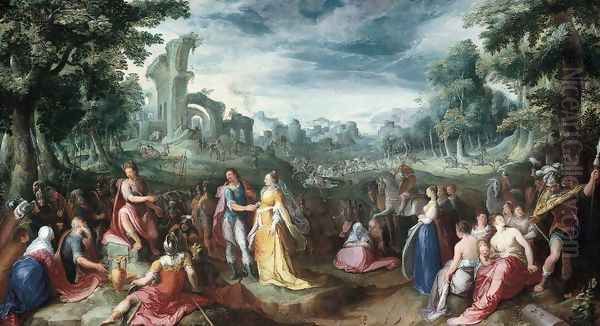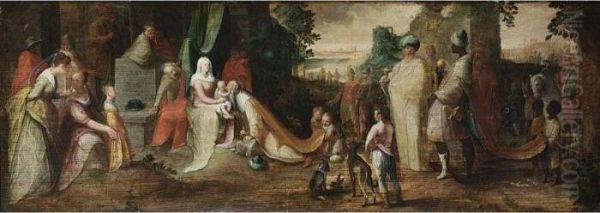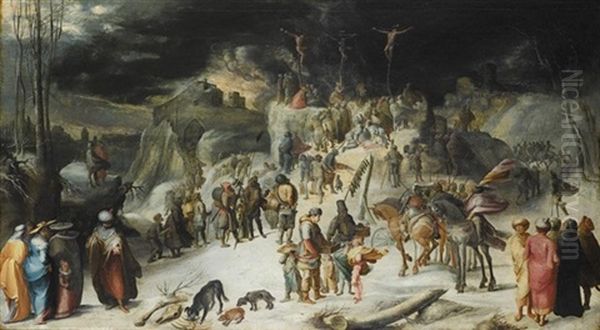Karel van Mander (1548-1606) stands as a colossus in the art history of the Northern Netherlands, a figure whose multifaceted career as a painter, poet, art theorist, and biographer shaped the trajectory of Dutch and Flemish art during a period of profound cultural and political transformation. Born in Meulebeke, West Flanders, then part of the Spanish Netherlands, Van Mander's life and work bridged the late Renaissance and the nascent Dutch Golden Age. His most enduring contribution, Het Schilder-boeck (The Book of Painters), published in 1604, remains an indispensable source for understanding the lives and works of early Netherlandish, German, and Italian artists, earning him the well-deserved epithet "the Northern Vasari," in homage to his Italian predecessor, Giorgio Vasari. This exploration delves into the life, artistic endeavors, influential writings, and the extensive network of artists connected to this pivotal figure.
Early Life and Artistic Formation
Karel van Mander was born into a family of Ghibelline gentry in Meulebeke. His early education likely included Latin, reflecting his family's status. His artistic inclinations emerged early, leading him to apprenticeships that would lay the foundation for his diverse career. Around 1568-1569, he began his formal training in Ghent under the tutelage of Lucas de Heere, a painter and poet of considerable repute. De Heere, himself a versatile figure, likely instilled in Van Mander an appreciation for both the visual arts and literature, a duality that would define Van Mander's own output.
Following his time with De Heere, Van Mander continued his studies in Kortrijk and later in Doornik (Tournai) with Pieter Vlerick around 1570. Vlerick, though less famous today, was respected in his time and further honed Van Mander's skills. During these formative years, Van Mander also engaged in writing poetry and plays, some of which were religious in nature, reflecting the intense spiritual climate of the era, marked by the Reformation and Counter-Reformation. His play The Deluge, for instance, was noted for its innovative staging, where he reportedly arranged for water to be poured from above to simulate rain, showcasing an early flair for dramatic effect and realism.
The Italian Sojourn: A Crucible of Influence

Like many ambitious Northern European artists of his generation, Van Mander recognized the indispensable value of an Italian sojourn. Italy, particularly Rome, was the epicenter of classical antiquity and High Renaissance achievement, a veritable university for aspiring painters. He embarked on this transformative journey around 1573, spending approximately four years absorbing the artistic currents of the peninsula.
His time in Rome, from roughly 1574 to 1577, was particularly formative. He immersed himself in the study of ancient ruins and the masterpieces of Renaissance giants such as Raphael and Michelangelo. It was in Rome that he forged a significant friendship with Bartolomeus Spranger, a fellow Fleming whose sophisticated, elegant, and often erotic Mannerist style was then gaining prominence. Spranger, who would later become court painter to Emperor Rudolf II in Prague, exerted a considerable influence on Van Mander's artistic development. Van Mander is even credited with discovering ancient catacombs in Rome, a testament to his inquisitive nature.
During his Italian period, Van Mander also traveled to Florence and Terni. In Terni, he reportedly painted a fresco depicting the St. Bartholomew's Day Massacre, a poignant subject given the religious strife engulfing Europe. This work, if it survives, would be a significant example of his early large-scale history painting. He also reputedly worked in the Vatican and collaborated with Spranger on designs for a triumphal arch for Emperor Rudolf II in Vienna, though he may have primarily assisted Spranger from Rome or during a brief visit to Vienna. The experience in Italy exposed him to the prevailing Mannerist style, characterized by elongated figures, complex poses, artificial grace, and a sophisticated intellectualism, which he would later help disseminate in the North.
Return to the Netherlands: Turmoil and New Beginnings
The escalating religious conflicts and the outbreak of plague eventually compelled Van Mander to leave Italy. He traveled north, possibly via Vienna to work with Spranger, and then to Kremsier (Kroměříž) in Moravia, where he worked for the Bishop of Olomouc. However, the instability of the region, marked by the Eighty Years' War (Dutch Revolt against Spanish rule), made his return journey fraught with peril. He recounted near-death experiences, including an instance where he was almost killed by Habsburg mercenaries.

By 1583, Van Mander had settled in Haarlem in the newly independent Dutch Republic. This city was becoming a vibrant artistic center, attracting talent from both the Northern and Southern Netherlands, the latter still under Spanish control. The move was partly necessitated by the religious persecution of Protestants (Van Mander was likely a Mennonite or at least sympathetic to Anabaptist ideals) in the Southern Netherlands. Haarlem offered a more tolerant environment and burgeoning patronage.
The Haarlem Academy and the Spread of Mannerism
In Haarlem, Van Mander became a central figure in a circle of artists who embraced and propagated the international Mannerist style. He formed a close association with two other leading artists: Hendrick Goltzius, a virtuoso engraver and later painter, and Cornelis Cornelisz van Haarlem, a painter known for his muscular nudes and dramatic compositions. Together, these three are often credited with founding an informal "Haarlem Academy" around 1583 or shortly thereafter.
This "academy" was likely more of a collaborative workshop and drawing society than a formal institution. A key innovation they introduced to Haarlem, and indeed to the Northern Netherlands, was the practice of drawing from live nude models, both male and female, as well as from plaster casts of classical sculptures. This practice, standard in Italy, was crucial for mastering human anatomy and achieving the sophisticated figure representation characteristic of Mannerism. Van Mander, having experienced this firsthand in Italy, was instrumental in its adoption.
The collaboration between Van Mander, Goltzius, and Cornelis van Haarlem was highly influential. Van Mander brought his theoretical knowledge and Italian experiences; Goltzius, through his brilliant engravings, disseminated their shared stylistic ideals across Europe; and Cornelis van Haarlem produced powerful paintings embodying these principles. Their collective efforts helped establish Haarlem as a leading center for late Mannerism in the North, influencing a generation of artists. Artists like Jacob de Gheyn II were also part of this vibrant Haarlem scene, absorbing these new artistic currents.
Van Mander's Artistic Oeuvre: Style and Representative Works
As a painter, Karel van Mander worked in the prevailing international Mannerist style, which he helped popularize in the Northern Netherlands. His paintings often feature elongated figures, elegant and sometimes contorted poses, vibrant and occasionally acidic colors, and a focus on mythological, allegorical, and biblical subjects that allowed for displays of erudition and artistic skill. While his fame as a writer has somewhat overshadowed his achievements as a painter, he produced a significant body of work.

His subjects were diverse. He painted religious scenes, such as The Adoration of the Shepherds (c. 1596-1598, Frans Hals Museum, Haarlem), which showcases his ability to handle complex multi-figure compositions with dynamic movement and expressive figures. Another notable religious work is The Continence of Scipio (Rijksmuseum, Amsterdam), demonstrating his interest in classical history and moral exemplars.
Mythological themes, popular among Mannerist artists for their potential for depicting nudes and dramatic narratives, also featured prominently. Works like Adam and Eve (various versions, one in the Pommersches Landesmuseum, Greifswald) allowed him to explore the human form, influenced by Italian models and the anatomical studies undertaken in the Haarlem Academy. His depiction of The Deluge, a theme he also explored in his early play, would have offered ample opportunity for dramatic composition and emotional intensity, though specific surviving paintings of this subject by him are less definitively identified. The Martyrdom of Saint Catherine is another example of a dramatic religious narrative that would fit his stylistic preferences.
Van Mander also produced portraits and designs for tapestries and stained glass. His style, while rooted in Mannerism, also shows a Netherlandish attention to detail and, in some works, a move towards greater naturalism that would characterize the subsequent Golden Age. However, it is fair to say that his direct artistic output, while accomplished, did not reach the same heights of innovation or fame as that of his contemporary Goltzius or his Italian inspirations like Spranger or Tintoretto. His true genius lay in his ability to synthesize, theorize, and communicate.
Het Schilder-boeck: A Monumental Achievement
Karel van Mander's most significant and lasting contribution is undoubtedly Het Schilder-boeck (The Book of Painters), published in Haarlem in 1604. This magnum opus was a comprehensive and ambitious undertaking, modeled in part on Giorgio Vasari's Le Vite de' più eccellenti pittori, scultori, ed architettori (Lives of the Most Excellent Painters, Sculptors, and Architects), first published in 1550 and expanded in 1568. Van Mander's work aimed to do for Northern European art what Vasari had done for Italian art: to provide a historical framework, biographical accounts, and theoretical underpinnings for the visual arts.
Het Schilder-boeck is divided into several distinct parts:

1. "Den Grondt der Edel Vry Schilder-const" (The Foundations of the Noble and Free Art of Painting): This opening section is a didactic poem in fifteen chapters, offering practical and theoretical advice to young painters. It covers topics such as drawing, proportion, composition, color theory, landscape painting, and the depiction of emotions and animals. It draws heavily on classical sources like Pliny the Elder and Italian theorists like Leon Battista Alberti, but also incorporates Van Mander's own observations and Netherlandish traditions. He emphasized the importance of inventio (invention) and drawing (tekenconst).
2. Lives of the Ancient Egyptian, Greek, and Roman Painters: This section provides biographies of classical artists, largely derived from Pliny and other ancient authors, establishing a historical lineage for the art of painting.
3. Lives of the Modern Italian Painters: This part features biographies of Italian Renaissance artists, from Cimabue and Giotto to contemporaries like Tintoretto and the Carracci brothers. Vasari was a primary source here, but Van Mander updated it with information on more recent artists and sometimes offered his own critical perspectives. He admired masters like Michelangelo, Raphael, and Titian.
4. Lives of the Illustrious Netherlandish and High German Painters ("Levens der Doorluchtighe Nederlandtsche en Hooghduytsche Schilders"): This is arguably the most original and valuable section of the book. It provides biographical accounts of nearly 250 Northern European artists, from the Van Eyck brothers and Rogier van der Weyden through to his own contemporaries like Pieter Bruegel the Elder, Hans Holbein the Younger, Albrecht Dürer, Lucas van Leyden, Frans Floris, Maarten van Heemskerck, Anthonis Mor, and many others, including his teachers Lucas de Heere and Pieter Vlerick, and his associates Goltzius and Spranger. For many of these artists, Van Mander's accounts are the earliest, and sometimes the only, significant sources of information. He included anecdotes, descriptions of works, and assessments of their artistic contributions.
5. "Wtlegghingh op den Metamorphosis Pub. Ovidij Nasonis" (Explanation of the Metamorphoses of Publius Ovidius Naso): This is an extensive commentary on Ovid's Metamorphoses, a key sourcebook for mythological subjects in Renaissance and Baroque art. Van Mander provided iconographical interpretations, explaining the stories and their allegorical meanings, making it an invaluable guide for artists tackling these themes.
6. "Uvtbeeldinge der Figueren" (Depiction of Figures): This final section offers an iconographical dictionary of allegorical figures, personifications, and attributes, serving as a practical handbook for artists.

Het Schilder-boeck was more than just a collection of biographies. It was an attempt to elevate the status of Northern art and artists, to provide a theoretical foundation for their practice, and to codify a history for an artistic tradition that was distinct from, yet in dialogue with, Italian art. Van Mander introduced new art critical terms into Dutch, such as those relating to invention, drawing, and coloring, thereby enriching the language of art discourse in the North. He championed history painting as the noblest genre and advocated for the study of both nature and classical models.
Anecdotes and Personal Insights from Het Schilder-boeck
Van Mander's Schilder-boeck is enlivened by numerous anecdotes that offer glimpses into the personalities and working methods of artists, as well as the cultural context of the time. For example, he recounts stories about Pieter Bruegel the Elder's humor and his deathbed instruction to his wife to burn certain satirical drawings that might cause her trouble. He tells of Frans Floris's prodigious talent but also his struggles with alcohol.
His own life experiences also subtly inform the text. His descriptions of religious persecution and the hardships faced by artists during times of war resonate with his own perilous journey back from Italy and his family's experiences (his ancestral village was reportedly plundered). His account of founding the Haarlem Academy with Goltzius and Cornelis van Haarlem, and their practice of drawing from life, underscores his commitment to artistic education and innovation. His commentary on Ovid also reveals his humanist learning and his desire to provide artists with the intellectual tools necessary for ambitious history painting. He even included a utopian description of the New World, reflecting the era's fascination with exploration and distant lands, perhaps viewing it as a place free from Europe's religious strife.
Influence and Legacy
The impact of Het Schilder-boeck was immediate and profound. It became the standard reference work on Netherlandish art for centuries and was essential reading for artists, collectors, and connoisseurs. It provided a sense of historical continuity and professional identity for Northern artists. Many later art biographers, such as Cornelis de Bie (author of Het Gulden Cabinet, 1662) and Joachim von Sandrart (author of Teutsche Academie, 1675-1679), were heavily indebted to Van Mander's work, often building upon or reacting to his accounts. Arnold Houbraken, in his De groote schouburgh der Nederlantsche konstschilders en schilderessen (1718–1721), also drew extensively from Van Mander.
Van Mander's advocacy for Italianate principles and the study of classical art significantly influenced the direction of Dutch art, particularly in the early 17th century. Artists like Abraham Bloemaert and Joachim Wtewael continued in the Mannerist vein he championed. Even artists who moved towards greater realism, such as the young Frans Hals (who is sometimes, though not definitively, cited as a pupil of Van Mander in Amsterdam), would have been aware of the theoretical framework and historical consciousness that Van Mander established. His emphasis on inventio and a learned approach to art resonated with the intellectual aspirations of the Dutch Golden Age.
Beyond art history, his commentary on Ovid's Metamorphoses remained a standard Dutch-language resource for understanding classical mythology for a long time. His didactic poem on the art of painting also served as a foundational text for art education in the Netherlands.
Later Years and Death
In his later years, Van Mander moved from Haarlem to Heemskerk for a period, possibly to work on Het Schilder-boeck in a quieter environment, and then to Amsterdam around 1603 or 1604, perhaps to oversee the printing of his great work. Amsterdam was by then rapidly eclipsing Haarlem as the primary commercial and cultural center of the Dutch Republic. He continued to paint and write, but his health may have been declining.
Karel van Mander died in Amsterdam on September 11, 1606, at the age of 58, just two years after the publication of Het Schilder-boeck. He was buried in the Oude Kerk (Old Church) in Amsterdam. While his own paintings, though accomplished, are not as widely celebrated today as those of some of his contemporaries, his literary and theoretical contributions have secured his place as one of the most important figures in the history of Northern European art.
Conclusion: The Enduring Significance of Karel van Mander
Karel van Mander was a pivotal figure who stood at the crossroads of artistic traditions and historical epochs. He was a conduit for Italian Renaissance and Mannerist ideas into the Northern Netherlands, yet he also championed the unique qualities of Northern art. His efforts to document the lives of artists, to provide a theoretical basis for their work, and to educate a new generation were instrumental in shaping the artistic landscape that would give rise to the Dutch Golden Age.
His Schilder-boeck is more than just a collection of biographies; it is a cultural monument, a testament to the burgeoning self-awareness and ambition of Northern European art. It provided a narrative, a history, and a set of ideals that would inspire and guide artists for generations. Through his writings, Van Mander not only preserved the memory of artists like Jan van Eyck, Pieter Bruegel the Elder, Albrecht Dürer, and countless others, but also actively shaped the way their contributions were understood and valued. As a painter, poet, theorist, and historian, Karel van Mander's legacy is multifaceted and enduring, a cornerstone upon which much of our understanding of Renaissance and early Baroque art in Northern Europe is built.